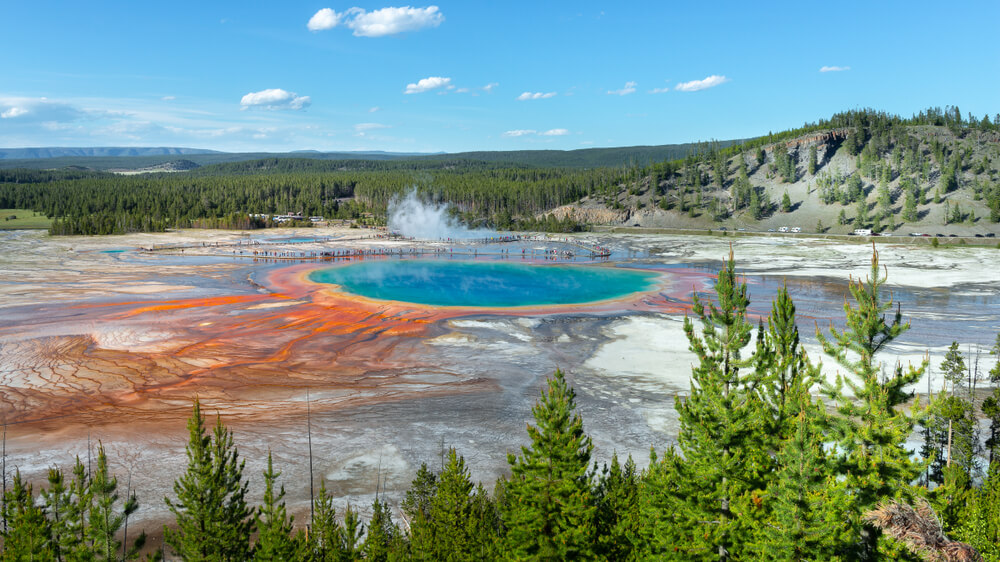Yellowstone's 'pulsating' territory the size of Chicago: what to expect
In northwestern Wyoming, in the center of Yellowstone National Park, there is a bubbling caldera - the scar of a giant volcanic eruption that occurred 640 thousand years ago. The park has an area of 3 sq. miles (472 square kilometers) spanning the caldera is full of geological wonders. Geysers emerge from the ground here and hot springs boil. All of them move under the influence of magma and fiery lava raging under the rock surface, writes National Geographic.

Photo: shutterstock
The Norris Geyser Basin, northwest of the caldera, houses more than 500 hydrothermal sites. The seething geysers change day by day, but at the same time, a much larger transformation is taking place. For more than two decades, an area larger than Chicago has been regularly rising and falling a few inches. In a hyperactive volcanic region such as Yellowstone, it is difficult to determine the exact causes of any such movement. But a recent publication in the Journal of Geophysical Research: Solid Earth may help explain why this piece of land is "pulsating."
“In all likelihood, Norris has been a deformation center for a very long time,” said Daniel Zurisin, co-researcher at the Volcanic Observatory of the American Geological Survey and one of the co-authors of the new study.
On the subject: 1,5 thousand Hiroshima: a chronicle of the most catastrophic volcanic eruption in the United States
To model possible variations of the changes occurring beneath its surface, scientists used information from ten years of satellite observations, data from radars and GPS located in the Norris basin. In the late 1990s, magma escaped to the area. As it solidified, its pressure increased, the earth rose, groundwater came to the surface. When magma or water came to the surface elsewhere, the earth sank. Today magma is estimated to be just a mile from the surface.
A new study proves that the supervolcano that created the Yellowstone Caldera, which erupted the last time 640 thousand years ago, is likely to not erupt in the near future. Instead, these geological movements can help explain why the world's most active geyser, Steamboat Park, has erupted at a record pace since March 2018. Researchers also suggest that changes under the Norris geyser pool may mean a slightly increased likelihood of hydrothermal explosions that occur in the pool.
Yellowstone's geology is complex, and subsoil exploration is particularly difficult. Scientists agree that magma is the explanation for the rising and falling lands.
“We're just starting to realize how dynamic the Norris Geyser Pool is,” explains Michael Poland, a researcher at the Yellowstone Volcanic Observatory in the United States, who did not participate in the new study.
The notorious Norris Geyser Pool
The Norris Geyser Basin is the oldest geothermal area in Yellowstone, the heat from which has been emanating for 115 thousand years. It is also the hottest area, where 459 degrees Fahrenheit (+237 Celsius) is recorded at a depth of a thousand feet (300 m) or so below the surface.
The Steamboat geyser in the region illustrates how radically and unexpectedly this boiling stretch of Yellowstone can change. A geyser 400 feet high (121,9 meters) rarely shot, with gaps between the main eruptions from four days to half a century. But since March 2018, he has been erupting once a week. 32 eruptions in 2018 set a record that was broken in 2019 when a geyser erupted 48 times.
Although the hyperactivity of this geyser has attracted public attention, scientists are more interested in studying the geological movements of this territory than the geyser. Between 1996 and 2004, an area of 18 miles increased by 4,7 inches (11,9 cm), and then decreased by 2,8 inches (7,1 cm) between 2005 and 2013. Then, from the end of 2013 to the beginning of 2014, the region suddenly began to rise again at a speed of 5,9 inches (14,9 cm) per year. This is the fastest climb ever seen in Yellowstone National Park.
In March 2014, a magnitude 4,9 earthquake struck the Norris Geyser Basin, which apparently stopped the sudden rise. The land gradually fluctuated between lowering and rising until the beginning of 2019. Now this territory is 5 inches (12,7 centimeters) higher than in 2000.
Earth tremors
To track the deformation of the Norris geyser pool, radar and GPS data from satellites were used. Geologists suspect that tremors began between 1996 and 2001, when magma rose and was only 9 miles (14,5 km) deep from the surface of the earth. This basin is located on the fault line known as the Norris Mammoth Corridor.
“Two geo-fault zones intersecting each other is the place where magma was able to penetrate the surface,” says Dzurisin.
This was the reason for the rise of the territory from 1996 to 2004. When the magma cooled, the liquids dissolved in it began to be squeezed to the surface. This process lowered the internal pressure of solidified magma, the mass began to deflate, like a holey balloon, which probably caused the lowering of the earth from 2005 to 2013.
Groundwater squeezed out due to these processes repeatedly fell into crevices under rock formations. Because of what the earth began to rise again. This cycle turned out to be elusive for scientists to observe, and they were not able to identify it and keep a chronicle of events. The new model is “a likely hypothesis, but by no means final,” says Poland. Perhaps the rise of the earth's surface is to blame for the water that collects under the rocky rocks after snowmelt. And when she leaves, the landscape falls again.
Geysers and possible hydrothermal explosions
Scientists suspect that magma is now directly below the surface of the Norris Geyser Pool. Craters of hydrothermal explosions that occurred thousands of years ago can be found throughout the region. They are formed due to the fact that boiling groundwater abruptly emerges to the surface, relieving pressure if the rock is cracking. This is an event that is almost impossible to predict.
At any time, a new hydrothermal explosion may occur in the Norris geyser pool, although large explosions rarely occur. If water accumulates near the surface of the pool, the probability of hydrothermal explosions may become slightly higher. But cracks in rock formations are complex and unpredictable. Any small changes that cannot be detected constantly increase or decrease the likelihood of an explosion.
The possibility of a geothermal explosion now remains a very controversial issue, because scientists do not recommend closing the region for visitors.
Researchers are also wondering if magma and groundwater accumulation could be related to the recent record number of Steamboat eruptions. In the 1960s and early 1980s, the geyser had similar bursts of activity, possibly also associated with the cycles of “respiration” of the earth in the basin.
But if this is true, then why exactly this geyser hosts the show when several others remain calm?
On the subject: Active volcanoes, lava fields and the world's most powerful telescopes: a trip to the island of Hawaii
Dzurisin says that the link between Steamboat hyperactivity and increasing magma levels is indirect, but "the timing is the same." In the future, he and his colleagues hope to study groundwater that goes to the surface to find out if they have chemical elements of magmatic origin.
Nevertheless, the fact that researchers were able to create a theory that could explain these major changes proves that the data accumulated over decades and modern scientific methods have been very useful. “Twenty years ago, that would have been impossible,” said Dzurisin.
Read also on ForumDaily:
Ten US national parks with the most unusual and scenic views
14 world attractions that mercilessly destroy tourists
12 incredible places to visit in Florida in 2020
Subscribe to ForumDaily on Google NewsDo you want more important and interesting news about life in the USA and immigration to America? — support us donate! Also subscribe to our page Facebook. Select the “Priority in display” option and read us first. Also, don't forget to subscribe to our РєР ° РЅР ° Р »РІ Telegram and Instagram- there is a lot of interesting things there. And join thousands of readers ForumDaily New York — there you will find a lot of interesting and positive information about life in the metropolis.











